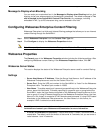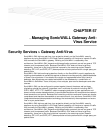
709
SonicOS Enhanced 4.0 Administrator Guide
CHAPTER 56
Chapter 56: Activating SonicWALL Client Anti-Virus
Security Services > Anti-Virus
By their nature, anti-virus products typically require regular, active maintenance on every PC.
When a new virus is discovered, all anti-virus software deployed within an organization must
be updated with the latest virus definition files. Failure to do so severely limits the effectiveness
of anti-virus software and disrupts productive work time. With more than 50,000 known viruses
and new virus outbreaks occurring regularly, the task of maintaining and updating virus
protection can become unwieldy. Unfortunately, many small to medium businesses don’t have
adequate IT staff to maintain their anti-virus software. The resulting gaps in virus defenses may
lead to data loss and decreased employee productivity.
The widespread outbreaks of viruses, such as NIMDA and Code Red, illustrate the problematic
nature of virus defense for small and medium businesses. Users without the most current virus
definition files allow these viruses to multiply and infect many other users and networks.
SonicWALL Client Anti-Virus prevents occurrences like these and offers a new approach to
virus protection. SonicWALL security appliance constantly monitors the version of the virus
definition file and automatically triggers download and installation of new virus definition files to
each user’s computer. In addition, the SonicWALL security appliance restricts each user’s
access to the Internet until they are protected, therefore acting as an enforcer of the company’s
virus protection policy. This new approach ensures the most current version of the virus
definition file is installed and active on each PC on the network, preventing a rogue user from
disabling the virus protection and potentially exposing the entire organization to an outbreak.
Note You must purchase an Anti-Virus subscription to enforce Anti-Virus through the SonicWALL
security appliance’s Management Interface.


















